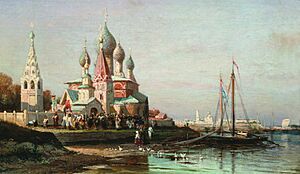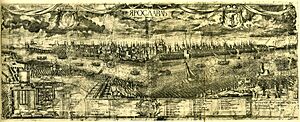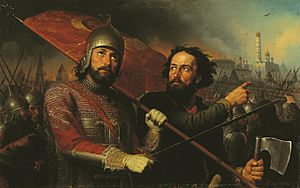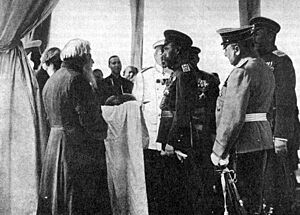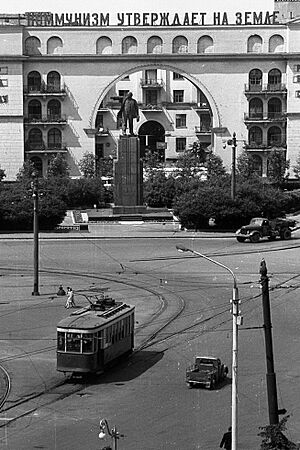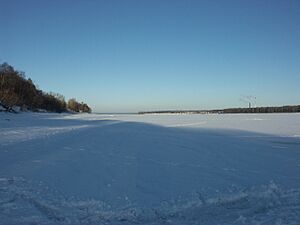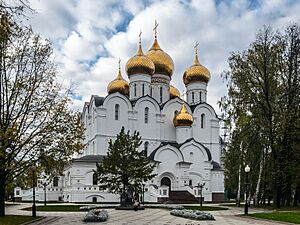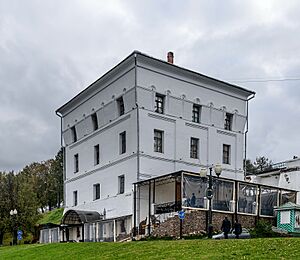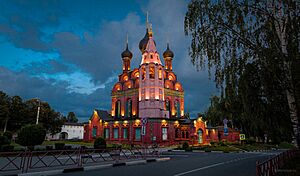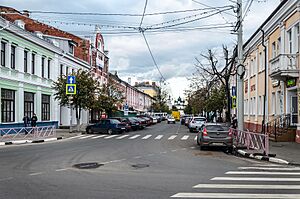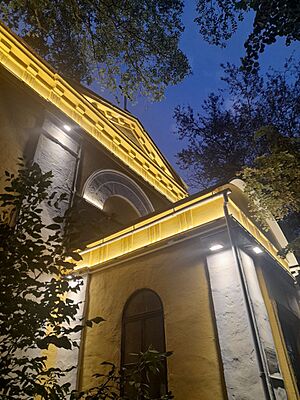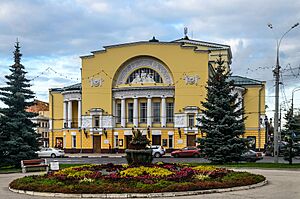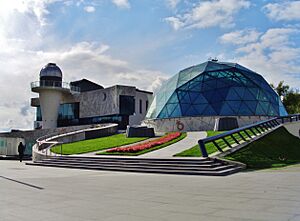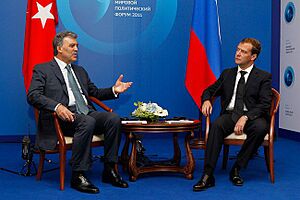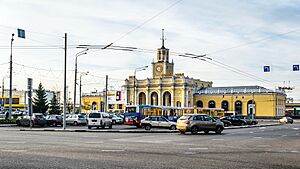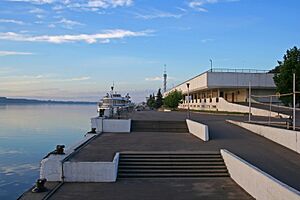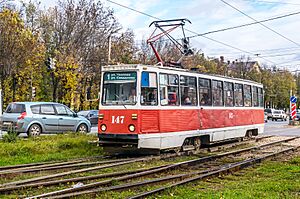Yaroslavl facts for kids
Quick facts for kids Yaroslavl (English)Ярославль (Russian) |
|
|---|---|
| - City - | |
 Clockwise, from top right: St. Alexander Nevsky's Chapel, St. John the Baptist's Church, Strelka Park from Volga Embankment, Znamenskaya Tower, Volkov Theater, St. Elijah the Prophet's Church |
|
|
|
|
| Administrative status | |
| Country | Russia |
| Federal subject | Yaroslavl Oblast |
| Administratively subordinated to | city of oblast significance of Yaroslavl |
| Municipal status | |
| Urban okrug | Yaroslavl Urban Okrug |
| Mayor | Artyom Molchanov |
| Representative body | City Duma |
| Statistics | |
| Area | 205.80 km2 (79.46 sq mi) |
| Population (2010 Census, preliminary) |
591,486 inhabitants |
| - Rank in 2010 | 23rd |
| Population (2020 est.) | 608,353 inhabitants |
| Density | 2,874/km2 (7,444/sq mi) |
| Time zone | MSK (UTC+04:00) |
| Founded | 1010 |
| Postal code(s) | 150000—150066 |
| Dialing code(s) | +7 4852 |
| Official website: https://city-yaroslavl.ru/ | |
Yaroslavl is a historic city in Russia. It is the main city of Yaroslavl Oblast. The city is about 250 kilometers (155 miles) northeast of Moscow.
Yaroslavl is located where the Volga River and the Kotorosl River meet. Its old city center is a World Heritage Site. This means it is a very special place recognized by UNESCO for its history and culture. Yaroslavl is also part of the Golden Ring of Russia. This is a group of old cities northeast of Moscow. They played a big role in Russian history.
Contents
History of Yaroslavl
Yaroslavl was once the capital of its own small kingdom, called the Principality of Yaroslavl, starting in 1218. In 1463, it became part of the larger Grand Duchy of Moscow.
In the 1600s, Yaroslavl was Russia's second-biggest city. For a short time in 1612, it was even the country's capital. This happened when Poland occupied Moscow. Today, Yaroslavl is an important industrial city. It has factories that make things like tires and diesel engines. Its location on major rivers helped it grow. These rivers were important for travel and power. Many railways and highways were built here because of the city's importance.
How Yaroslavl Began
The oldest signs of people living here are from 5,000 to 3,000 BCE. These were found on the left bank of the Volga River.
In the 800s, a large settlement of Scandinavians and Slavs formed near Yaroslavl. It was called Timerevo. Many old burial mounds have been found there. Inside, archaeologists found Scandinavian weapons and a large collection of Arabian coins. This shows that "proto-Yaroslavl" was a major trading center. It was part of the Volga trade route.
Founding the City
Yaroslavl is the oldest city on the Volga River. It was founded in 1010 by Yaroslav the Wise. He was a prince of Kievan Rus'. He chose a spot where the Volga, Kotorosl, and Medveditsa rivers met. This spot was easy to defend. Yaroslav and his men built the first Yaroslavl Kremlin here.
The city's name comes from its founder, Yaroslav. The first recorded event in Yaroslavl was a famine in 1071. This led to the Rostov Uprising of 1071.
By the 1100s, two monasteries, Petropavlovsky and Spaso-Preobrazhensky, were built. They were outside the city at first. Later, the city grew to include them. For its first 200 years, Yaroslavl was a small fortified city.
Yaroslavl's Own Kingdom
In the early 1200s, Yaroslavl became a main home for Prince Konstantin of Rostov. Before he died in 1218, he gave Yaroslavl to his son Vsevolod. Vsevolod ruled it as the Principality of Yaroslavl. This kingdom was independent until 1463. Then, it joined the Grand Duchy of Moscow. From then on, Yaroslavl's history was tied to Moscow and Russia.
Fires and Invasions
In the 1200s and 1300s, Yaroslavl was mostly made of wood. This meant many terrible fires. Some fires almost destroyed the whole city. For example, a big fire happened in 1221.
The city also faced constant danger from invaders. The Mongol Horde attacked many times. In 1257, troops from the Golden Horde attacked Yaroslavl. They killed many people and the prince's family. Today, there is a memorial church and cross where this happened. In 2005, a mass grave was found with over 300 bodies. These were victims of a Mongol attack in 1238.
More attacks by the Golden Horde happened in 1293 and 1322. The Plague also hit in 1278 and 1364. Yaroslavl had to be rebuilt many times. Some stone buildings, like the Spaso-Preobrazhensky Monastery, were built. The Monastery of Maria of Tolga was built in 1314.
The 16th Century and Time of Troubles
Yaroslavl still had big fires in the 1500s. People stopped building with wood. New buildings were made of stone. This meant most of the medieval city changed. The Spaso-Preobrazhensky Monastery was destroyed in 1501. It was rebuilt in a few years. Its cathedral, built in 1506–1516, is the oldest unchanged building in the city.
By the mid-1500s, the monastery had stone walls and watchtowers. These were for spotting attackers. During the rule of Ivan the Terrible, Yaroslavl's monasteries received many gifts. Ivan IV visited Yaroslavl several times.
Yaroslavl's economy grew in the mid-1500s. This was because of its location on the Volga River. It connected Moscow to the port of Arkhangelsk. Yaroslavl became important for international trade. Many warehouses were built for merchants, especially from England and Germany.
The good times ended with the Time of Troubles (1598–1613). Yaroslavl suffered from famine. Polish-Lithuanian troops tried to take over. A pretender to the Russian throne, False Dmitry II, gained support in Yaroslavl. But his forces also plundered the city. This led to uprisings. In 1609, a Russian peasant army formed to free Volga cities.
In May 1609, a Polish army tried to capture Yaroslavl. But the citizens hid behind earthen walls and in the Kremlin. The siege lasted until May 22. The Poles could not take the city.
Polish forces still controlled Moscow. In 1611, Kuzma Minin and Prince Dmitry Pozharsky formed another peasant army. On their way to Moscow, they stayed in Yaroslavl for months. From April to June 1612, Yaroslavl became the de facto capital of Russia. Important state matters were decided here. After resting in Yaroslavl, the army liberated Moscow. This ended the Polish-Lithuanian occupation.
Yaroslavl in the 20th Century
Before World War I, Yaroslavl was a big industrial city. But the October Revolution of 1917 and the Russian Civil War (1917–1920) hurt the city's economy. The population shrank.
The Yaroslavl Uprising (July 6–21, 1918) had bad results. Some people tried to remove the new Bolshevik government. Rebels took parts of the city. But the Red Army surrounded and bombed Yaroslavl. About 600 people died. Around 2,000 buildings were destroyed or damaged.
Yaroslavl's economy grew during the Soviet Union's industrialization. A power plant opened in 1926. Factories started making synthetic rubber and tires. The Yaroslavl Automobile Works continued making vehicles.
During World War II, German forces did not occupy Yaroslavl. But the city was a big transport hub. The railway bridge over the Volga was the only crossing point. So, Yaroslavl was a target for air raids in 1942–1943. On June 11, 1943, over 120 people died. About 200 buildings were destroyed. Most factories made weapons for the Soviet Red Army. About 200,000 people from the Yaroslavl area died in the war. A monument and eternal flame honor them.
Many children from the Blockade of Leningrad were sent to Yaroslavl for safety. The city also had a camp for German prisoners of war.
In the second half of the 20th century, Yaroslavl continued to industrialize. The Yaroslavl Refinery opened in 1961. New residential areas grew, even on the left bank of the Volga. A new bridge for cars opened in 1965. By 1968, the city's population reached over half a million. It has been growing since then.
In July 2005, Yaroslavl's historic city center became a UNESCO World Heritage Site. This was because of its unique architecture and city planning. The city began preparing for its 1,000th anniversary in 2010. A lot of money was invested in roads and railways. A new bridge over the Volga, the Jubilee Bridge, opened in 2006. The Yaroslavl Zoo opened in 2008 and expanded in 2010.
Yaroslavl also became a place for global policy discussions. The International Conference 'The Modern State and Global Security' started in 2009. Important leaders like Russian President Dmitry Medvedev attended.
On September 7, 2011, most of the city's ice hockey team, Lokomotiv Yaroslavl, died in a plane crash. This happened on takeoff from Yaroslavl's Tunoshna Airport.
Geography and Climate
Where is Yaroslavl Located?
Yaroslavl is in the eastern part of Yaroslavl Oblast. Nearby towns include Tutayev (34 km northwest) and Gavrilov-Yam (37 km south). The historic center is north of the Kotorosl River's mouth. It is on the right bank of the larger Volga River. The city covers about 205 square kilometers (79 sq mi). It includes areas south of the Kotorosl and on the left bank of the Volga.
Yaroslavl has almost 600,000 residents. It is the largest city on the Volga until Nizhny Novgorod. It is a major transport hub. Many important roads, railways, and waterways pass through it. The area around Yaroslavl has rolling hills and mixed forests. There are also large swampy areas.
Yaroslavl's Climate
Yaroslavl has a typical temperate continental climate. This means winters are snowy, cold, and dry. Summers are usually temperate and warmer.
Winter starts around November and lasts five months. January is the coldest month, with an average of -12.0°C (10.4°F). Temperatures can drop below -20°C (-4°F). Sometimes, they can even reach -35°C to -40°C (-31°F to -40°F). The lowest recorded temperature is -46°C (-51°F). The Volga River usually freezes in winter. Snow cover is typically 35–50 cm (14–20 in) thick.
Spring has little rain. April gets 30–40 mm (1.2–1.6 in) of rain. Rain increases in May. From late March to April, snow and ice melt. Temperatures in April can reach +20°C (68°F).
Summers are often wet with heavy rainstorms. The hottest time is usually June/July. Days can be over +30°C (86°F). Fall lasts two months from September. It has high humidity, fewer sunny days, and changing temperatures. The average yearly rainfall is 591 mm (23.3 in). July is the wettest month.
| Climate data for Yaroslavl, Russia (1961–1990) | |||||||||||||
|---|---|---|---|---|---|---|---|---|---|---|---|---|---|
| Month | Jan | Feb | Mar | Apr | May | Jun | Jul | Aug | Sep | Oct | Nov | Dec | Year |
| Mean daily maximum °C (°F) | −8.2 (17.2) |
−5.8 (21.6) |
0.1 (32.2) |
9.0 (48.2) |
17.8 (64.0) |
21.4 (70.5) |
23.3 (73.9) |
21.5 (70.7) |
14.9 (58.8) |
7.2 (45.0) |
−0.2 (31.6) |
−5.2 (22.6) |
8.0 (46.4) |
| Daily mean °C (°F) | −12.0 (10.4) |
−10.0 (14.0) |
−4.3 (24.3) |
4.5 (40.1) |
12.0 (53.6) |
15.7 (60.3) |
17.9 (64.2) |
16.1 (61.0) |
10.4 (50.7) |
4.1 (39.4) |
−2.7 (27.1) |
−8.4 (16.9) |
3.6 (38.5) |
| Mean daily minimum °C (°F) | −15.8 (3.6) |
−14.2 (6.4) |
−8.6 (16.5) |
0.0 (32.0) |
6.2 (43.2) |
10.1 (50.2) |
12.5 (54.5) |
10.7 (51.3) |
5.9 (42.6) |
0.9 (33.6) |
−5.2 (22.6) |
−11.6 (11.1) |
−0.8 (30.6) |
| Average precipitation mm (inches) | 37 (1.5) |
27 (1.1) |
26 (1.0) |
40 (1.6) |
52 (2.0) |
65 (2.6) |
84 (3.3) |
64 (2.5) |
55 (2.2) |
52 (2.0) |
46 (1.8) |
43 (1.7) |
591 (23.3) |
City Symbols
Yaroslavl has a coat of arms and a flag. Both show two symbols: a brown bear and a halberd. These symbols come from the legend of how the city was founded.
The first coat of arms was given in 1778. It showed a silver bear holding a golden halberd. In 1856, it was changed slightly. An imperial crown was added above the shield. Golden oak leaves and a blue ribbon were also added around it. This design stayed until 1918.
After the October Revolution, the Soviet government removed old symbols. Yaroslavl had no official symbols for many years. The current coat of arms was adopted in 1995. It uses the colors and bear design from 1856. But the oak leaves and ribbon were removed. The imperial crown was replaced by the Cap of Monomakh. This is a symbol of Russian power.
The flag of Yaroslavl was adopted in 1996. It is a simple light blue rectangle. The city's coat of arms (from 1995) is in the center. It takes up at least one-third of the flag's size.
Population of Yaroslavl
| Census | Population |
|---|---|
| 1897 | 72 000 |
| 1926 | 112 238 |
| 1939 | 299 359 |
| 1959 | 407 071 |
| 1970 | 517 314 |
| 1979 | 596 951 |
| 1989 | 632 991 |
| 2002 | 613 088 |
| 2010 | 591 486 |
| 2021 | 577 279 |
| 2022 | 570 824 |
In 2021, Yaroslavl was the 27th largest city in Russia by population. It had 577,279 people. Almost half of the Yaroslavl Oblast's population lives in the city. The city has about 2,805 people per square kilometer.
Population by Age
| Population in thousands | ||
|---|---|---|
| Age | 2008 | 2009 |
| Younger than working age | 81.3 | 82.2 |
| Of these, children ages 1–6 | 32.4 | 33.3 |
| Of working age | 380.9 | 379.9 |
| Older than working age | 143.0 | 144.2 |
City Layout and Districts
Yaroslavl is divided into six city districts. The city center is on the northern bank of the Kotorosl River. It is the oldest part of the city. Most of the famous buildings and attractions are here. This includes the Volkov Theater and the Church of Elijah the Prophet. Pyatyorka is a residential area north of the center.
Across the Kotorosl River are Frunzensky and Krasnoperekopsky City Districts. Frunzensky is a newer district, built after World War II. It has many typical Soviet-style buildings. Krasnoperekopsky is one of the oldest parts of Yaroslavl. It used to have most of the city's factories. Today, it still has some industry.
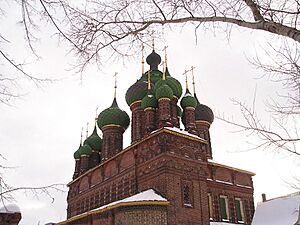
Krasnoperekopsky includes Neftestroy, a growing area near the Yaroslavl Refinery. It has a new hockey arena. The Perekop area, within Krasnoperekopsky, is older. It has some of Yaroslavl's most famous churches. These include the Church of Saint John the Baptist.
North of the center is an industrial area. It has the tire factory and engine plant. Further north is Dzerzhinsky City District. Its main area is Bragino. Bragino is the largest part of Yaroslavl by population. It is mostly a residential area for middle-income families.
On the other side of the Volga River is Zavolzhsky City District. This used to be a quiet, rural area. Now, it is growing fast with new buildings and large stores. Forests separate the apartment blocks.
Travel and Culture
Yaroslavl is one of the eight cities in Russia's Golden Ring. It is the largest city in this group. The city is known for its beautiful buildings. It also has many cultural attractions.
Architecture and Old Town
| UNESCO World Heritage Site | |
|---|---|
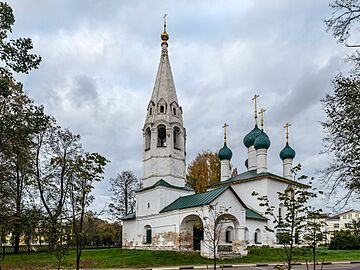
Church of Saint Nicholas in Yaroslavl
|
|
| Criteria | Cultural: (ii)(iv) |
| Inscription | 2005 (29th Session) |
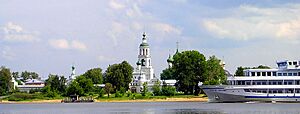
Even after wars, Yaroslavl has kept many buildings from the 1600s, 1700s, and 1800s. This makes it a great example of Russian architecture. The city center covers about 600 hectares (1,500 acres). It has about 140 protected historical buildings. Since 2005, the center and the Spaso-Preobrazhensky Monastery are UNESCO World Heritage Sites.
Exploring the Old Town

The old town is shaped like a triangle. The Kotorosl and Volga rivers form two sides. The third side is made by the city's planned streets from the 1700s and 1800s.
The most famous building is the 'Spaso-Preobrazhensky' ('Transfiguration of the Savior') Cathedral. It is part of the Spassky Monastery. This monastery was founded in the 1100s. Its cathedral, built in 1516, is the oldest detached building in the city.
The Spaso-Preobrazhensky Monastery was built like a citadel. It could be used as a fortress during wars. Today, you can still see its thick 16th-century white walls and watchtowers. Inside are grand churches with decorated interiors. There is also a gatehouse church. The monastery played a big role in history. It helped the Russian peasant army defend the city. This army later freed Moscow from Polish invaders.
In the late 1700s, the oldest known text of the Tale of Igor's Campaign was found in the monastery's library. This famous medieval Russian story is now on display there.
Outside the monastery's main gate is Bogolavyenskaya Square (Epiphany Square). The Epiphany Church is at the south end of the square. This church, built in 1684–1693, has five domes. Its clock tower is a great example of 17th-century architecture. The paintings inside the church were done by local artists around 1680. They are still in good condition.
The streets leading from Bogolavyenskaya Square show the city planning of the 1700s and 1800s. They were built in 1820–1821 as new boulevards. They replaced old earthen and wooden forts. Two old watchtowers, the Vassily tower and Volzhskaya tower, still stand.
Inside the old city limits, you can find many examples of classicism. The municipal trade rows 'Gostiny Dvor' were built in 1813–1818. Their style, with many Ionic columns, is common for Russian market halls. This style matches the neoclassical Volkov Theater, built in 1911.
At the end of Komsomolskaya Boulevard is 'Volkov Square'. From there, the boulevard goes towards 'Red Square' and the Volga embankment. Yaroslavl's Red Square was named in the 1920s after the Soviet Red Guards. It is not named for being "beautiful" like Moscow's Red Square. The 'aristocrat's meeting house' is on Red Square. It is now the main building for the city's Yaroslavl State University. The city's main fire department, built in 1911, is also here.
East of the boulevard is the old city's "nucleus." It has narrow streets and famous buildings. The Church of Elijah the Prophet is one of them. It was completed in 1650. This church, with its five onion domes, is a cross and dome-style church. Its architecture is typical of Moscow designs. It is famous for its interior fresco paintings. These were painted by about fifteen artists around 1680. The square where the church stands was planned to be the city's central square. Today, it is used for official events.
The city center's streets mix classical and religious architecture. Important public buildings include the 1785 'Governmental offices'. The Volga embankment, built in the 1840s, is a popular place for walks.
The southern part of the city center has many parks. This area was once the wooden Yaroslavl Kremlin. The Kremlin burned down in 1658 and was not rebuilt. The Church of Maria, built in 1642, was rebuilt in 2010.
Yaroslavl is home to the Volkov Theater, built in 1750. It is the oldest theater in Russia. The city has many Russian Orthodox churches. It also has one Russian Old Believers church, one Baptist church, one Lutheran church, one Armenian Apostolic church, one mosque, and one synagogue.
Theater and Cinema
Yaroslavl has three theaters. The most famous is the 'Volkov Theater'. It is in a large neoclassical building in the old town. Founded in 1750 by Fyodor Volkov, it is officially Russia's first theater. The Volkov Theater is known as a leading dramatic institute. It is a very respected place for actors to perform. Today, it has two stages and about 1,000 seats.
Other theaters in Yaroslavl include the State Puppet Theater (founded 1927). There is also a children's and youth theater (Yaroslavl State Theater for Young Spectators, founded 1984). The Yaroslavl Chamber Theater was founded in 1999. The city also has a philharmonic (founded 1937) and a permanent circus (founded 1963).
There are about ten movie theaters. The oldest, 'Rodina', was built in 1959. It has been modernized and can show 3D films. The city also has modern multiplex cinemas.
Yaroslavl has a large municipal Planetarium. It was founded in 1948. In April 2011, a new 'Valentina Tereshkova' planetarium opened. It is named after Valentina Tereshkova, the first female cosmonaut.
Global Policy Forum
Yaroslavl has become known for hosting high-level political talks. These are part of the Yaroslavl Global Policy Forum. The Russian government organizes this event. It has been held since 2009. It is one of the most important political forums in the world. Many foreign officials attend each year. Past guests include prime ministers from France, Italy, and Spain.
In 2011, Turkish President Abdullah Gül was a guest. Yaroslavl was chosen to host this event because of its long history. It has been a meeting point for different cultures and a major trading post for 1,000 years.
Education in Yaroslavl
Yaroslavl has many schools and universities. It offers primary, middle, and higher education. Students can study for both master's and bachelor's degrees.
The city has eight state-funded universities. These include Yaroslavl State University, Yaroslavl State Technical University, and Yaroslavl State Medical Academy. There are also private universities and branches of Moscow universities. The Yaroslavl Seminary trains new Russian Orthodox priests.
In 2008, Yaroslavl had about 187 preschools. They had about 26,000 children enrolled. Around 48,100 children were in 100 general schools. In 2010, about 16,000 people worked in Yaroslavl's education sector.
Transportation in Yaroslavl
Yaroslavl is a hub for many major automotive, rail, and riverboat routes. The M8 connects the city to Moscow and Arkhangelsk. There is one main railway bridge and two car bridges over the Volga River. The Kotorosl River has four car bridges and one railway bridge.
Road Travel
The city has been building a bypass road. This helps reduce traffic in the city center. In August 2010, the first part of this bypass opened. It connects the Jubilee Bridge to a relief road.
Intercity and regional buses use the city's main bus terminal. Buses go to towns in Yaroslavl Oblast like Pereslavl-Zalessky and Rybinsk. They also go to larger cities like Moscow, Saint Petersburg, and Kazan.
Train Travel
Yaroslavl is a major center for the Northern Railway. Its headquarters are in the city. There are two main passenger train stations: Yaroslavl-Glavny and Yaroslavl-Moskovsky. Many long-distance trains stop here. A fast electric train, 'Express', connects Yaroslavl to Moscow. Local trains serve nearby areas.
Air Travel
Yaroslavl's main airport is Tunoshna International. It was built as a World War II airbase. The airport handles different types of aircraft. There are flights to Moscow's Domodedovo International Airport.
There are also two smaller airports: Levtsovo Air Base and Karachikha air field. Levtsovo is mainly for cargo planes and helicopters. The Yaroslavl Air Club is at Karachikha. This is one of Russia's oldest air clubs. Valentina Tereshkova started her flight training here.
Water Travel
Yaroslavl River Port handles about 3.5 million tons of goods each year. The port can be used for six months, from May to October. It serves large river cruise ships. It also has regular services to nearby towns along the Volga.
Public Transportation
The city has a network of public transport. This includes buses, trolley-buses, and tram lines. Here's how many people used different types of transport (in millions):
| 2007 | 2008 | 2009 | |
|---|---|---|---|
| Municipal and private bus services | 65.4 | 64.9 | 74.5 |
| Trams | 24.6 | 19.7 | 16.3 |
| Trolleybuses | 43.5 | 35.7 | 30.4 |
Over 600 different bus routes run daily. The Yaroslavl tram system is one of Russia's oldest. It has been running since 1900. As of 2011, it has four routes. The number of tram routes has been reduced since 2004. The number of trams used has also fallen to 43 by 2011.
Since 1949, the city has also had trolleybuses. They run on nine different routes.
Sports in Yaroslavl
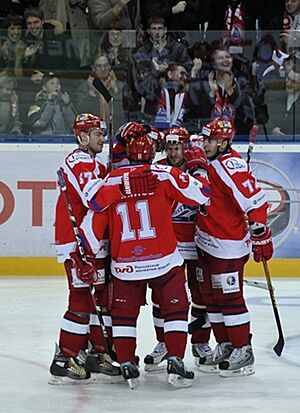
FC Shinnik Yaroslavl is the city's association football (soccer) club. It plays in the Russian First Division.
Lokomotiv Yaroslavl is the city's ice hockey team. They were champions of Russia in 1996–1997, 2001–2002, and 2002–2003. On September 7, 2011, most of the team died in a plane crash. This happened when their plane crashed on takeoff from Yaroslavl airport. The city later co-hosted the 2012 Canada–Russia Challenge to honor the team.
Famous People from Yaroslavl
- Aleksandr Lyapunov, mathematician and physicist
- Maksim Tarasov, Olympic pole vaulter
- Valentina Tereshkova, first woman in space
- Andrei Khomutov, hockey player
- Fyodor Volkov, founder of the first Russian theater
- Nikolay Nekrasov and Mikhail Kuzmin, poets
- Leonid Sobinov, opera singer
- Konstantin Ushinsky, founder of Russian education
- Elena Grosheva, Olympic gymnast
- Denis Grebeshkov, hockey player
- Lyubov Ivanovskaya, triathlete
- Vladimir Tarasenko, NHL hockey player
- Artemy Troitsky, rock critic
- Alexander Vasyunov, hockey player
- Artem Anisimov, NHL hockey player
- Aleksandr Petrov (animator), Oscar-winning animator
- Alex Sipiagin, musician
- Ivan Nepryaev, hockey player
- Anna Malova, Miss Russia 1998 and model
- Ivan Provorov, NHL hockey player
- Boris Stark, missionary and priest
- Alexander Shibaev, table tennis player
- Sofiya Kruglikova, Slovene based illustrator
Sister Cities
Yaroslavl is twinned with these cities:
Images for kids
See also
 In Spanish: Yaroslavl para niños
In Spanish: Yaroslavl para niños




